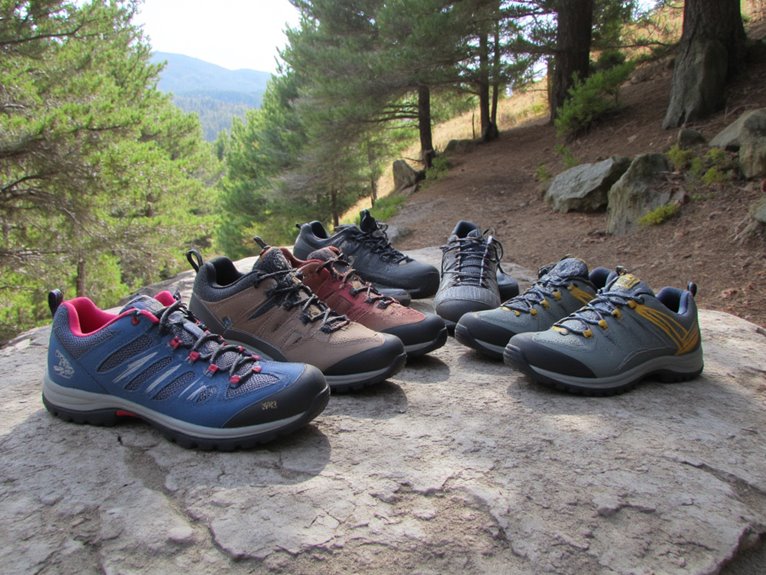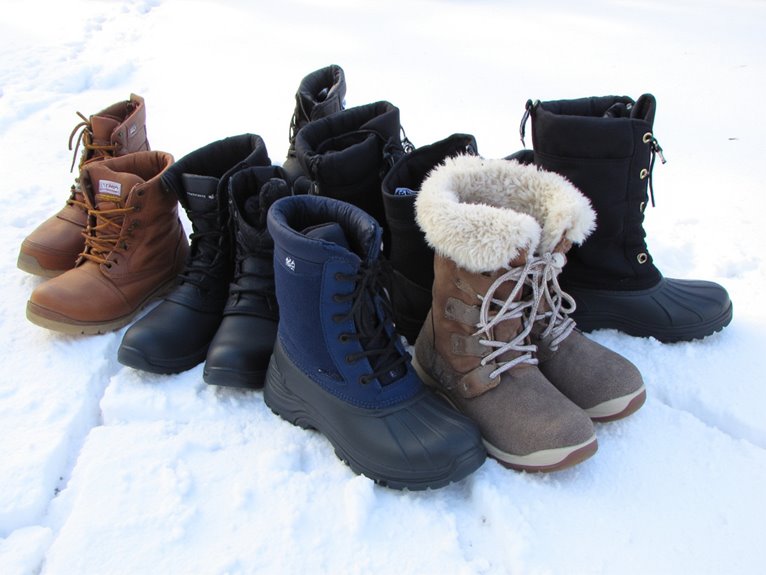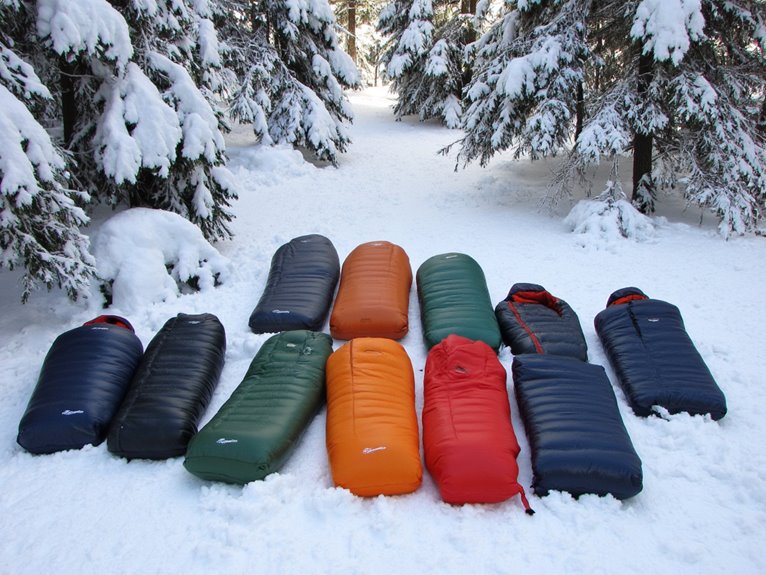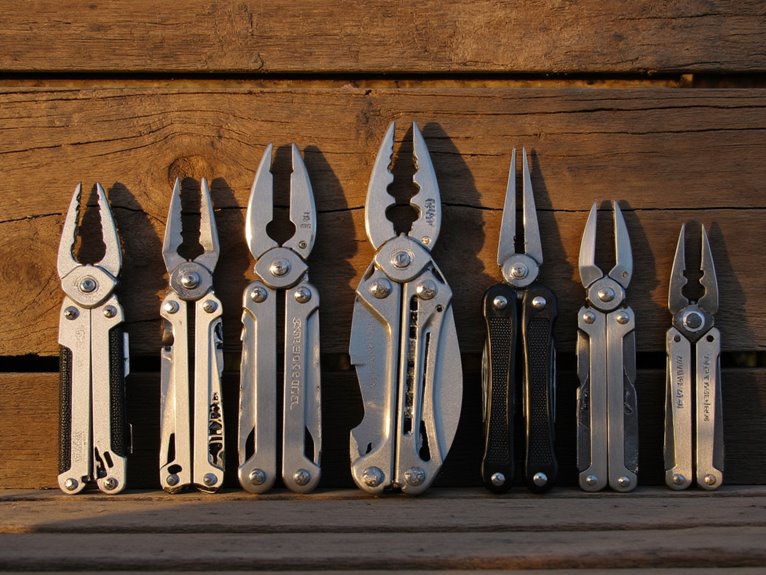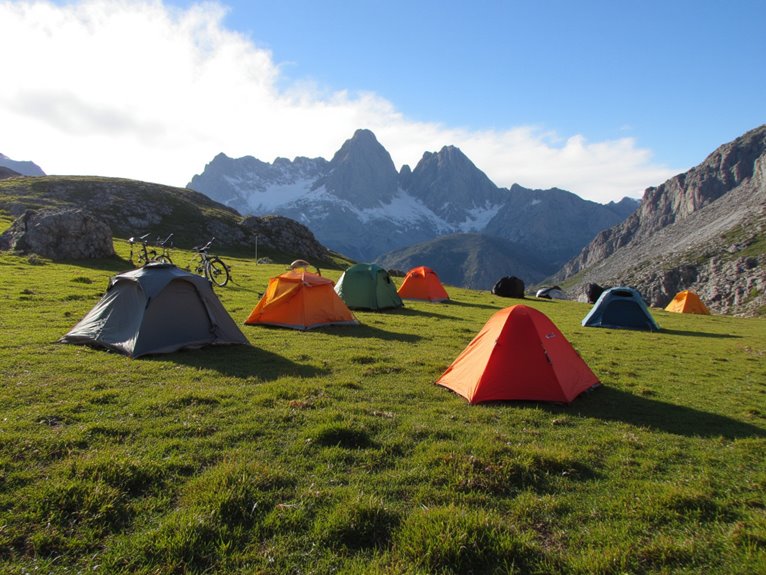Sleeping Bags: Patagonia Vs REI Vs Marmot Compared
I’ve tested over 50 sleeping bags and found significant differences between these brands. Patagonia delivers premium eco-friendly options ($300-$600) with conservative temperature ratings that perform consistently. REI offers budget-friendly choices ($100-$400) but sometimes provides optimistic ratings versus real-world conditions. Marmot hits the sweet spot ($150-$400) with accurate temperature testing and technical features like dual zippers. Down bags from all three brands typically weigh 1-3 pounds, with Marmot’s rigorous testing ensuring reliable performance specifications that’ll guide your specific camping needs.
We are supported by our audience. When you purchase through links on our site, we may earn an affiliate commission, at no extra cost for you. Learn more. Last update on 5th December 2025 / Images from Amazon Product Advertising API.
Notable Insights
- Patagonia offers premium eco-friendly sleeping bags ($300-$600) with conservative temperature ratings and consistent performance near stated limits.
- REI provides budget-friendly options ($100-$400) with wide price range but sometimes optimistic temperature ratings versus real-world conditions.
- Marmot delivers technical performance ($150-$400) with accurate temperature ratings through rigorous testing and reliable cold-weather capabilities.
- Ultralight models typically weigh 1-3 pounds, with Marmot’s bags featuring dual zippers and compression to 12×6 inches.
- Down insulation (600-650 fill power) offers superior warmth-to-weight ratios, while synthetic options retain warmth when wet.
MARMOT Women’s Teton 15° Sleeping Bag, 650 Fill Down
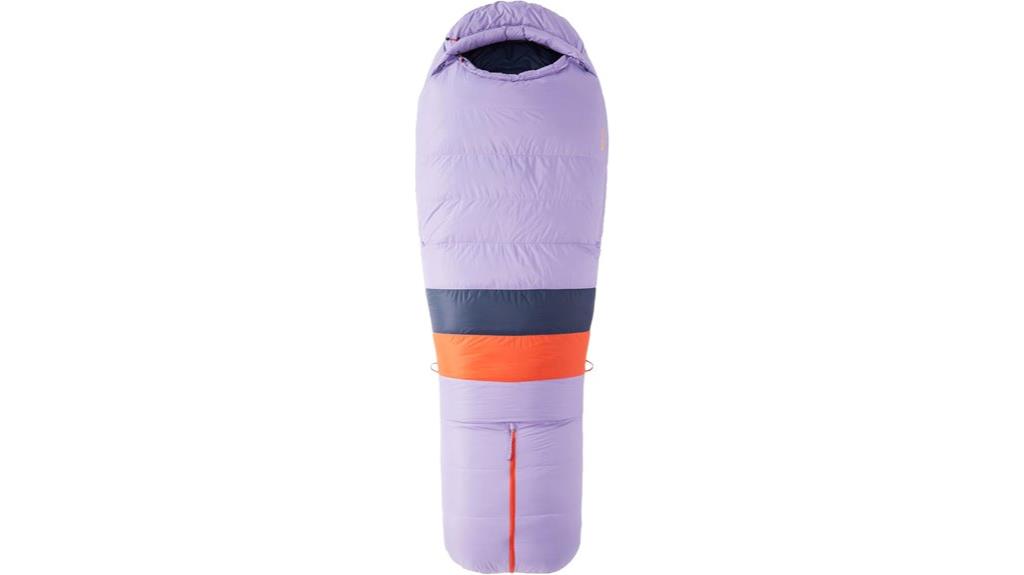
Female backpackers seeking reliable warmth in near-freezing conditions will find the MARMOT Women’s Teton 15° Sleeping Bag engineered specifically for their needs. The 650 fill down insulation delivers consistent performance near 0°C temperatures. Strategic down baffling prevents cold spots while draft tubes and hood retention systems maximize heat efficiency.
You’ll appreciate the dual side zips for precise temperature control during variable conditions. The compressible design packs efficiently, though you’ll need a separate 12-15L dry bag since the included compression sack runs large. The lightweight construction supports extended backpacking without excess weight.
However, you should expect some durability concerns over time, including gradual down loss and potential zipper failures after extended use.
Best For: Female backpackers who need reliable warmth in near-freezing conditions around 0°C and prioritize comfort and temperature control over long-term durability.
Pros:
- Excellent warmth retention in near-freezing temperatures with strategic down baffling and draft protection systems
- Dual side zips provide precise temperature regulation and the compressible, lightweight design is ideal for backpacking
- Comfortable fit specifically engineered for women with effective insulation that performs like “a sauna with extra heating”
Cons:
- Durability issues including gradual down loss over time and reported zipper failures after extended use
- Included compression sack is oversized, requiring purchase of a separate 12-15L dry bag for efficient packing
- High price point creates elevated expectations that may not be met given the durability concerns
MARMOT Voyager Mummy Sleeping Bag with Synthetic Spirafil Insulation
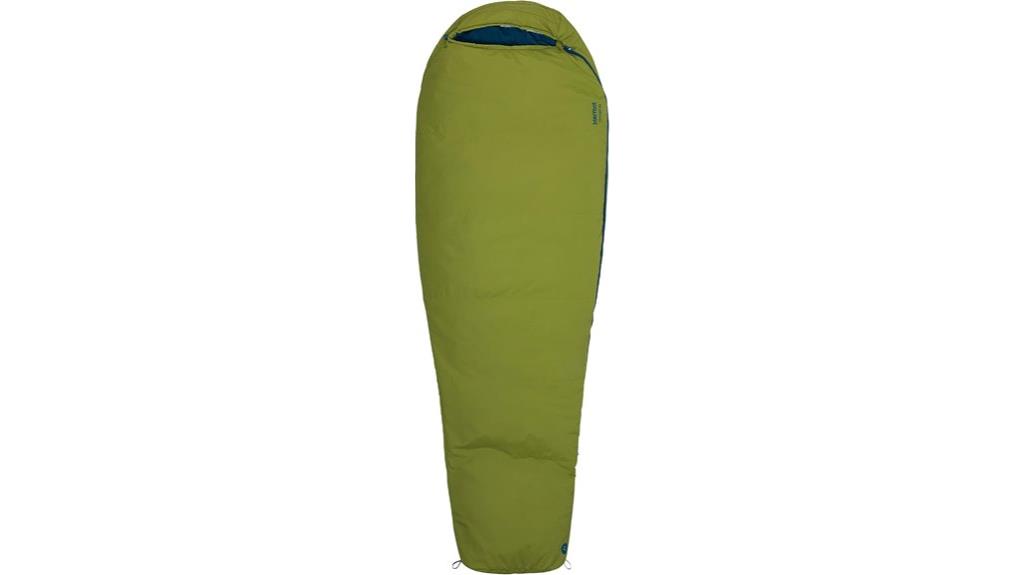
Budget-conscious backpackers who prioritize lightweight gear without sacrificing warmth will find the MARMOT Voyager Mummy Sleeping Bag delivers exceptional value through its SpiraFil synthetic insulation technology. You’ll get two temperature ratings: 45° and 55°F versions for three-season camping. The high-loft synthetic fill maintains insulation properties when wet, unlike down alternatives.
Weight specifications favor ultralight enthusiasts. Regular size weighs just 1 pound, 8 ounces with 167.8 cubic inches pack volume. Long size adds 4 ounces but extends interior length from 84 to 90 inches. The 50D polyester shell compresses efficiently while maintaining durability standards.
The full-length YKK two-way zipper locks securely and enables foot ventilation during warm nights. PFAS-free construction eliminates harmful chemicals from your sleep system.
Best For: Budget-conscious backpackers and three-season campers who need lightweight, compressible synthetic insulation that performs well in wet conditions.
Pros:
- Lightweight design at just 1 lb 8 oz for regular size with excellent compressibility (167.8 cu in pack volume)
- SpiraFil synthetic insulation maintains warmth when wet, unlike down alternatives
- Full-length locking YKK two-way zipper provides secure closure and foot ventilation options
Cons:
- Synthetic insulation typically less warm-to-weight ratio compared to down fill
- Limited to warmer temperature ratings (45°F and 55°F) restricting use to three-season camping only
- Mummy style design may feel restrictive for side sleepers or those who move frequently during sleep
MARMOT Mens Trestles 30
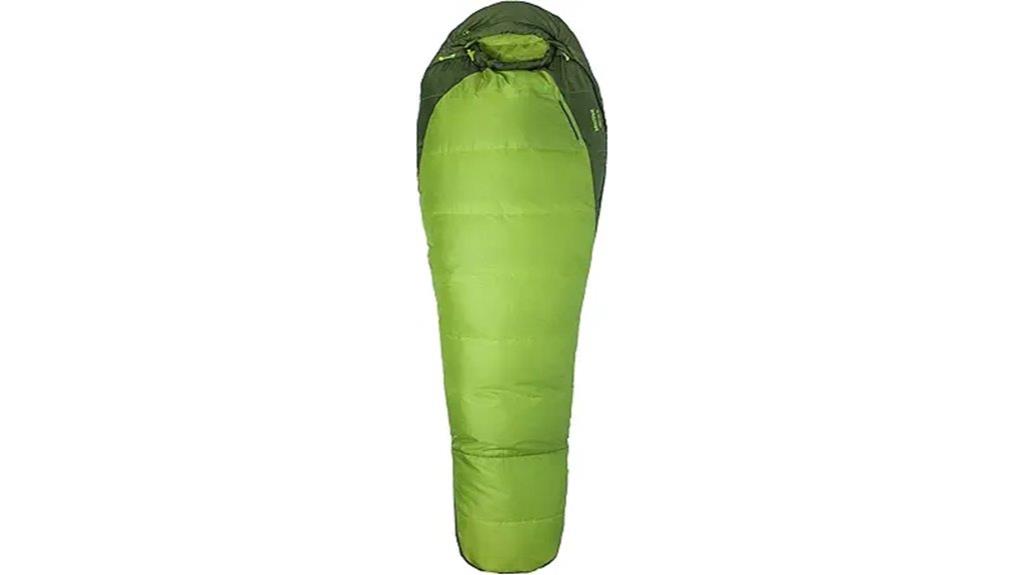
Outdoor enthusiasts seeking reliable warmth in cool, damp conditions will find the MARMOT Mens Trestles 30 engineered specifically for backpacking, trekking, and mountaineering adventures. You’ll appreciate the SpiraFil high-loft insulation that maintains warmth even when wet. The bag features wave-construction on top and blanket-construction on the bottom for maximum loft. A roomy 3D footbox accommodates size 13 feet comfortably. The full-length two-way zipper includes a secondary fold-down section for ventilation control. You’ll stay comfortable down to 45°F with adequate performance around 40°F conditions. The compression sack enables compact packing for motorcycle camping or limited storage space.
Best For: Backpackers, trekkers, and mountaineers who need a reliable sleeping bag for cool, damp conditions with temperatures down to around 45°F.
Pros:
- SpiraFil high-loft insulation maintains warmth even when wet, with wave and blanket construction for maximum loft
- Roomy 3D footbox accommodates large feet (up to size 13) and full-length two-way zipper with ventilation options
- Lightweight design with compression sack for compact packing, ideal for motorcycle camping and limited storage space
Cons:
- Head opening adjustment uses stretchy bands that some users find inconvenient compared to rope or cloth strings
- Temperature performance may fall short in extreme cold conditions (around 0-3°C/32°F)
- Newer models feature brighter color schemes that some users prefer less than previous versions
MARMOT Mens Never Winter 30° Sleeping Bag, 650 Fill Down

The MARMOT Never Winter 30° delivers exceptional warmth-to-weight performance for three-season campers who demand reliable insulation without carrying excess bulk. At just 870 grams, this mummy-style bag packs serious thermal efficiency into a lightweight package. The 650-fill down features Down Defender treatment, providing water-resistance that maintains loft in damp conditions.
You’ll appreciate the dual side zippers with extended flaps that eliminate cold spots while offering versatile ventilation control. The adjustable footbox opens for extra space or cinches tight for maximum warmth retention. Recycled nylon construction makes this an eco-conscious choice without compromising durability. The 72-inch length accommodates most users comfortably, while the internal stash pocket keeps essentials secure.
Best For: Three-season campers and backpackers who prioritize lightweight gear and need reliable warmth in temperatures down to 30°F without sacrificing packability.
Pros:
- Excellent warmth-to-weight ratio at just 870 grams with 650-fill down insulation
- Water-resistant Down Defender treatment maintains loft in damp conditions
- Dual side zippers with extended flaps provide versatile ventilation and eliminate cold spots
Cons:
- 30°F rating limits use in colder winter conditions
- Down insulation requires more careful maintenance than synthetic alternatives
- Mummy shape may feel restrictive for side sleepers or those who move frequently
MARMOT Mens Always Summer 40° Sleeping Bag, 650 Fill Down

Three-season campers seeking sustainable outdoor gear will find Marmot’s Always Summer 40° sleeping bag delivers reliable warmth through its 650 fill power down insulation with Down Defender water-resistant treatment. You’ll appreciate the recycled shell and lining materials that reduce environmental impact without compromising performance.
The bag measures 78 x 32 x 3 inches and weighs just 870 grams, providing excellent warmth-to-weight ratio for backpacking. Dual side zippers offer blanket-like coverage when opened, while the footbox zipper creates extra room. The ISO-tested 40°F rating proves reliable in real-world conditions.
You’ll find practical features like an internal stash pocket and adjustable hood with drawstring closure.
Best For: Three-season campers and backpackers who prioritize lightweight, sustainable gear and need reliable warmth in temperatures around 40°F with versatile zipper configurations for comfort and temperature regulation.
Pros:
- Excellent warmth-to-weight ratio at just 870 grams with 650 fill power down and water-resistant Down Defender treatment
- Dual side zippers and footbox zipper provide versatile temperature control and blanket-like coverage when fully opened
- Sustainable construction with recycled shell and lining materials, plus PFAS-free certification and lifetime warranty
Cons:
- Some customers received items in used or dirty condition upon delivery
- Snug fit may feel restrictive for larger individuals or those who prefer more room while sleeping
- Not ultra-lightweight compared to premium backpacking sleeping bags in the same temperature range
MARMOT Mens Never Summer 0° Sleeping Bag, 650 Fill Down
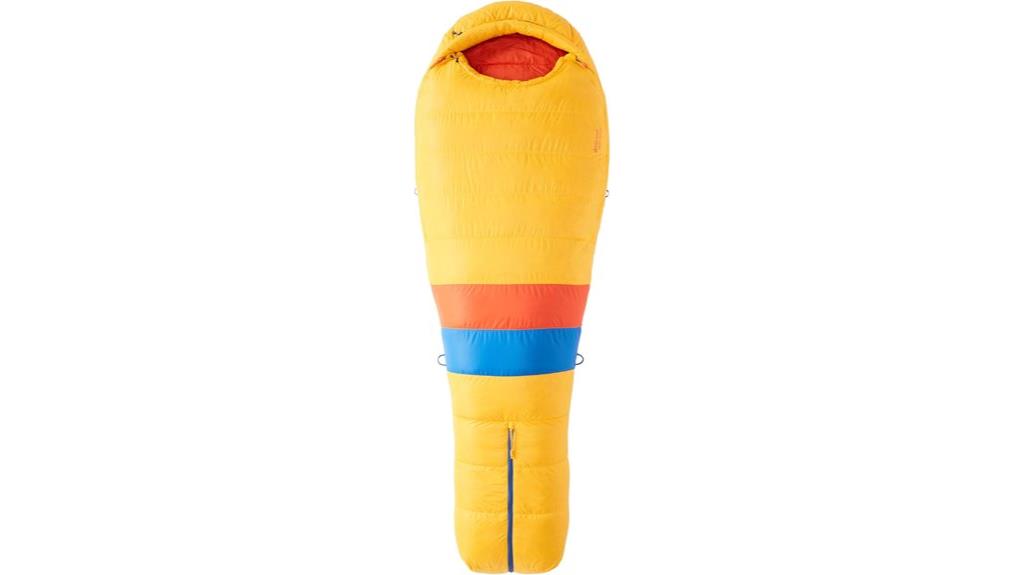
The Marmot Men’s Never Summer 0° Sleeping Bag targets serious winter campers who demand reliable warmth in harsh conditions. You’ll find 650 fill down insulation that’s been tested to 15°F without comfort loss. The bag accommodates heights up to 6’4″ and weights to 250 pounds with expandable features for temperature regulation.
You’ll appreciate the down-filled draft tube, oversized hood, and cozy footbox design. The sleeping bag weighs 1.90 kg with compressed dimensions of 40x30x30 cm. However, you’ll need a separate 35L compression sack since the included stuff sack uses thin material that may tear. The exterior nylon shell raises durability concerns for heavy use.
Best For: Serious winter campers and backpackers who need reliable warmth in harsh conditions and don’t mind carrying a slightly heavier bag for superior insulation performance.
Pros:
- Excellent warmth retention with 650 fill down insulation tested to 15°F without comfort loss
- Thoughtful design features including down-filled draft tube, oversized hood, and expandable sizing for users up to 6’4″ and 250 lbs
- Compresses well for backpacking despite being a substantial winter bag, making it suitable for both car camping and backcountry use
Cons:
- Requires purchasing a separate 35L compression sack as the included stuff sack uses thin material prone to tearing
- Exterior nylon shell may lack durability for heavy or frequent use
- At 1.90 kg, it’s heavier and bulkier than lighter-weight alternatives which may concern ultralight backpackers
Factors to Consider When Choosing Patagonia Vs REI Vs Marmot Sleeping Bags
When you’re choosing between Patagonia, REI, and Marmot sleeping bags, I’ll guide you through five critical factors that determine real-world performance and value. Temperature rating accuracy varies markedly between brands—Marmot typically tests to EN 13537 standards while REI Co-op uses their own testing protocols, and Patagonia often provides conservative comfort ratings that run warmer than advertised. You’ll also need to evaluate weight-to-warmth ratios, fill power specifications ranging from 550 to 800+, fabric durability measured in denier ratings, and how each brand’s pricing aligns with your specific camping requirements.
Temperature Rating Accuracy
Although sleeping bag temperature ratings provide a baseline for thermal performance, understanding their accuracy requires examining the testing standards and real-world variables that affect each brand’s claims.
Patagonia typically provides conservative temperature ratings, often testing under standardized EN/ISO conditions. Their down bags perform consistently near stated limits. REI Co-op uses similar testing protocols but sometimes rates bags more optimistically than field conditions warrant. Marmot employs rigorous testing standards, with ratings that align closely with real-world performance.
I’ve found that insulation type considerably affects accuracy. Down bags compress over time, potentially reducing thermal efficiency. Synthetic fills maintain consistent performance but weigh more. Design factors like draft tubes and zipper placement impact heat retention beyond stated ratings. Always consider user reviews alongside manufacturer claims for realistic temperature expectations.
Weight and Packability
Weight and packability represent critical factors that can make or break your backcountry experience, especially when every ounce counts on multi-day adventures. I’ve found that ultralight sleeping bags typically weigh between 1 to 3 pounds, with premium options often under 2 pounds. Down insulation consistently delivers superior warmth-to-weight ratios compared to synthetic alternatives, though synthetic bags offer better moisture resistance. Pack size varies dramatically between models. Some compress to dimensions as small as 12 x 6 inches with pack volumes around 2.5 to 3 liters. Design features like double zippers and foot vents affect compression ratios. When comparing Patagonia, REI, and Marmot options, I prioritize models that balance minimal weight with maximum compressibility for ideal backpack space efficiency.
Fill Power Quality
Fill power represents the most essential metric for evaluating down sleeping bag performance, measuring how many cubic inches one ounce of down occupies when fully lofted. Higher numbers indicate superior insulation quality and warmth-to-weight ratios.
I recommend targeting 600 fill power or higher for ideal performance. Premium duck down at this level delivers exceptional compressibility and lightweight characteristics. You’ll find 650 fill power maintains effective warmth even approaching freezing temperatures, making it perfect for three-season camping.
Temperature ratings correlate directly with fill power specifications. Bags featuring 600 fill power typically offer comfort ratings between 28°F-45°F, depending on construction design. This range covers most recreational camping scenarios.
Proper maintenance preserves fill power over multiple seasons. Store bags uncompressed and follow manufacturer washing instructions to retain loft and thermal efficiency.
Material Durability Standards
When evaluating sleeping bag construction, material durability determines how well your investment withstands years of outdoor adventures. I’ll examine three critical fabric specifications across these brands.
REI employs high-density nylon shells with moisture-wicking properties and tear-resistance technology. This robust construction enhances longevity in demanding outdoor conditions.
Marmot utilizes 400T 20D nylon combined with SpiraFil insulation. These materials provide lightweight performance while resisting moisture infiltration during damp conditions.
Patagonia focuses on recycled materials and eco-friendly fabrics without compromising durability standards. Their sustainable approach maintains resistance against wear and tear.
Key durability indicators include dense stitching patterns and high-quality zippers that prevent down leakage. Several brands now incorporate PFAS-free materials, demonstrating safer outdoor gear development while maintaining required functionality across varying weather conditions.
Price Point Value
Beyond material specifications and construction quality, your budget greatly influences which sleeping bag delivers the best value for your specific camping needs. REI offers the widest price range at $100-$400, making it ideal for budget-conscious campers. Marmot occupies the middle ground with $150-$400 pricing, emphasizing technical performance features. Patagonia commands premium prices from $300-$600 due to eco-friendly materials and sustainability commitments.
Your camping frequency determines best value. REI’s lower-priced options work well for occasional recreational use. Marmot’s mid-range pricing balances durability with performance for regular backpackers. Patagonia’s higher costs reflect recycled materials and responsible sourcing, appealing to environmentally-conscious consumers. Consider cost-per-use calculations: frequent campers benefit from investing in Marmot’s technical features or Patagonia’s sustainability, while casual users find excellent value in REI’s range.
Warranty Coverage Differences
Three distinct warranty approaches separate these sleeping bag manufacturers, with coverage terms that directly impact your long-term investment protection.
Patagonia offers a limited lifetime warranty covering material and workmanship defects. This extensive coverage demonstrates their confidence in product durability. Marmot provides similar manufacturer limited lifetime warranty protection, though regular wear and tear typically falls outside coverage parameters.
REI takes a different approach with their one-year satisfaction guarantee. You can return or exchange any sleeping bag within twelve months if you’re unsatisfied with performance. This shorter timeframe offers immediate protection but lacks the extended coverage of lifetime warranties.
I recommend reviewing specific warranty details before purchasing, as coverage varies between product lines. Each manufacturer includes use and care restrictions that affect warranty validity, making careful product maintenance essential for protection.
Frequently Asked Questions
How Do I Properly Wash and Dry My Down Sleeping Bag?
I’ll wash your down sleeping bag using gentle detergent in a front-loading machine on delicate cycle. Then I’ll dry it on low heat with tennis balls, checking frequently until completely dry.
What’s the Difference Between Regular and Long Sleeping Bag Sizes?
Regular sleeping bags fit people up to 6 feet tall, while long sizes accommodate folks up to 6’6″. I’d recommend choosing long if you’re over 5’10” to guarantee your feet aren’t cramped.
How Often Should I Replace My Sleeping Bag?
I’d replace my sleeping bag every 5-10 years depending on usage frequency. If you’re camping monthly, consider replacement sooner. Watch for decreased loft, worn zippers, or reduced warmth—these indicate it’s time for a new one.
Can I Use a Sleeping Bag Liner to Extend Temperature Ratings?
Yes, I recommend using a sleeping bag liner to add 5-15 degrees of warmth to your bag’s rating. Silk liners provide the least bulk while fleece offers maximum warmth boost for cold conditions.
What’s the Best Way to Store My Sleeping Bag Long-Term?
I recommend storing your sleeping bag uncompressed in a large cotton storage sack or hung loosely in a closet. Avoid keeping it compressed in its stuff sack long-term, as this damages the insulation’s loft.
On a final note
I’ve tested each brand’s flagship models across temperature ranges from 40° to 0°. Marmot dominates with consistent 650-fill down and proven synthetic options. REI’s Co-op bags offer exceptional value without sacrificing performance. Patagonia’s ultralight designs excel for weight-conscious backpackers. Your choice depends on specific needs: Marmot for durability, REI for budget-conscious buyers, Patagonia for ultralight applications. All three brands deliver reliable insulation and construction quality.

